Now Reading: Find the Solution Components in a Specific Solution
-
01
Find the Solution Components in a Specific Solution
Find the Solution Components in a Specific Solution

Whenever we do a solution migration or deployment, it is of utmost importance that we perform certain pre-deployment and post-deployment checks. One of these checks is to validate if all the components have been successfully migrated or not to the target environment. Today, we will use PowerShell script to fetch a list of all the components within a specific solution. This script can be modified to perform comparison between the source and target solutions and help automate the process during validation.
Table of Contents
- Introduction to the Solution Component Table
- Understanding the Structure of the Solution Component Table
- Leveraging the Solution Component Table to get the list of all components
- Filtering Component by Component Types
- Other Use Cases
- Best Practices for Using the Solution Component Table
- Conclusion
Introduction to the Solution Component Table
The Solution Component Table is a foundational element in Microsoft Dataverse that provides detailed insights into the individual components of a solution. Solutions in Dataverse are containers for apps, entities, workflows, and other resources that are packaged together for deployment and management. The Solution Component Table acts as a registry, cataloging all components within a solution and their interdependencies.
This table empowers developers, administrators, and architects to manage solutions effectively by offering a granular view of their components. Whether you’re troubleshooting, auditing, or preparing for deployment, the Solution Component Table can be a valuable tool in your toolkit.
Understanding the Structure of the Solution Component Table
The Solution Component Table contains the following key fields:
- SolutionComponentId: A unique identifier for each component.
- SolutionId: The solution to which the component belongs.
- ComponentType: The type of component (e.g., entity, workflow, plugin, etc.). To learn more on the component type, check out this Microsoft Learn documentation.
- ObjectId: The GUID of the actual object (e.g., the entity or workflow).
- IsMetadata: Indicates whether the component is metadata.
- CreatedOn: The date and time the component was added to the solution.
- ModifiedOn: The last modified timestamp for the component.
Understanding these fields is crucial for leveraging the table effectively.
Leveraging the Solution Component Table to get the list of all components
By querying the Solution Component Table, you can retrieve a comprehensive list of all components within a specific solution.
Example Script:
I have a solution called My Blog Components with solution ID a7536908-113b-f011-877a-7c1e52328e88. Lets get the list of components in this solution.
#Script
# Authenticate with Dataverse
$connection = Connect-CrmOnline -Username james@personal.onmicrosoft.com -ServerUrl "org2afa465b.crm8.dynamics.com"
# Define the FetchXML to query the Solution Component Table
$fetchXml = @"
<fetch>
<entity name="solutioncomponent">
<attribute name="componenttype" />
<attribute name="createdby" />
<attribute name="createdon" />
<attribute name="ismetadata" />
<attribute name="modifiedon" />
<attribute name="objectid" />
<attribute name="rootsolutioncomponentid" />
<attribute name="solutioncomponentid" />
<attribute name="solutionid" />
<filter>
<condition attribute="solutionid" operator="eq" value="a7536908-113b-f011-877a-7c1e52328e88" />
</filter>
</entity>
</fetch>
"@
# Execute the FetchXML query
$results = Get-CrmRecordsByFetch -Fetch $fetchXml
$results.CrmRecords | ForEach-Object {
[PSCustomObject]@{
SolutionComponentId = $_.solutioncomponentid
ComponentType = $_.componenttype
ObjectId = $_.objectid
CreatedOn = $_.createdon
}
} | Format-Table -AutoSize
This script connects to Dataverse, retrieves all components within a specific solution, and outputs their details. Here’s how it works:
- Connect to Dataverse: The script uses the
Connect-CrmOnlinecommand with OAuth credentials to establish a connection. - Define FetchXML Query: The query specifies the attributes to retrieve (e.g.,
solutioncomponentid,componenttype,solutionid, etc.). - Execute Query: The
Get-CrmRecordsByFetch command runs the FetchXML query against Dataverse. - Output Results: The script iterates through the results and outputs key details (e.g.,
SolutionComponentId,ComponentType,ObjectId, andCreatedOn) for each component.
Expected output: 3 components – 1 canvas app, 1 power automate flow and 1 connection reference.

Script Output:

Filtering Component by Component Types
You can filter components by their type using the ComponentType field. For instance, if you only want to list Canvas Apps (Component Type value 300) only within the solution, we can modify the script as below:
(Note: ComponentType values correspond to specific component types; consult this MS documentation for the complete list.)
Example Script:
# Authenticate with Dataverse
$connection = Connect-CrmOnline -Username james@personal.onmicrosoft.com -ServerUrl "org2afa465b.crm8.dynamics.com"
# Define the FetchXML to query the Solution Component Table
$fetchXml = @"
<fetch>
<entity name="solutioncomponent">
<attribute name="componenttype" />
<attribute name="createdby" />
<attribute name="createdon" />
<attribute name="ismetadata" />
<attribute name="modifiedon" />
<attribute name="objectid" />
<attribute name="rootsolutioncomponentid" />
<attribute name="solutioncomponentid" />
<attribute name="solutionid" />
<filter>
<condition attribute="solutionid" operator="eq" value="a7536908-113b-f011-877a-7c1e52328e88" />
</filter>
<filter>
<condition attribute="componenttype" operator="eq" value="300" />
</filter>
</entity>
</fetch>
"@
# Execute the FetchXML query
$results = Get-CrmRecordsByFetch -Fetch $fetchXml
$results.CrmRecords | ForEach-Object {
[PSCustomObject]@{
SolutionComponentId = $_.solutioncomponentid
ComponentType = $_.componenttype
ObjectId = $_.objectid
CreatedOn = $_.createdon
}
} | Format-Table -AutoSize
Expected Output: 1 component i.e. 1 canvas app
Script Output:

Other Use Cases
- Migration Planning: Extract all components and their details for migration to another environment.
- Component Versioning: Monitor changes to ensure the correct versions of components are deployed.
- Troubleshooting Missing Dependencies: Quickly identify missing or broken dependencies in a solution.
- Identifying Dependencies: The Solution Component Table also helps in understanding dependencies between components. This can prevent issues during deployment by ensuring all required components are included.
- Auditing Changes and Customizations: By tracking the CreatedOn and ModifiedOn fields, you can audit when components were added or updated. This is invaluable for maintaining compliance and understanding the evolution of your solutions.
Best Practices for Using the Solution Component Table
- Maintain Documentation: Use the table to create a documented inventory of your solutions.
- Use Filters Effectively: Leverage filtering to focus on relevant components.
- Regular Audits: Periodically review the table to ensure solutions remain optimized and compliant.
- Integrate with Automation: Automate solution validation processes using Power Automate or scripts.
Conclusion
The Solution Component Table is a powerful resource within Dataverse that enables comprehensive solution management. By leveraging its capabilities through PowerShell scripts, you can streamline development, ensure robust deployments, and maintain the integrity of your applications. Start exploring the Solution Component Table today to unlock its full potential!
Check James Yumnam’s original post https://jamesyumnam.com/2025/05/28/find-the-solution-components-in-a-specific-solution/ on jamesyumnam.com which was published 2025-05-27 19:47:00
















